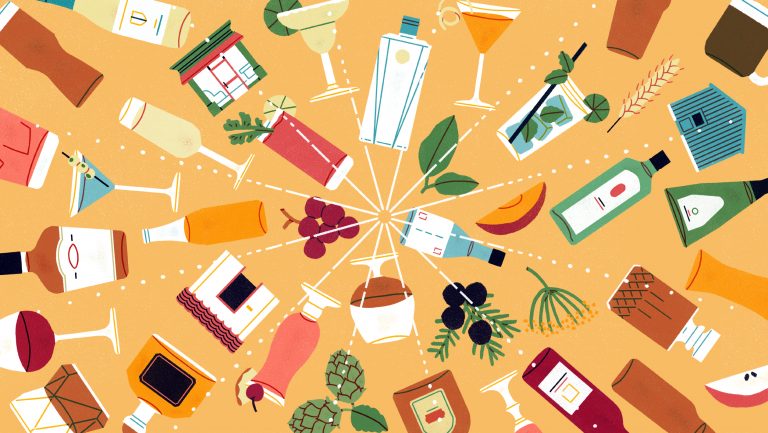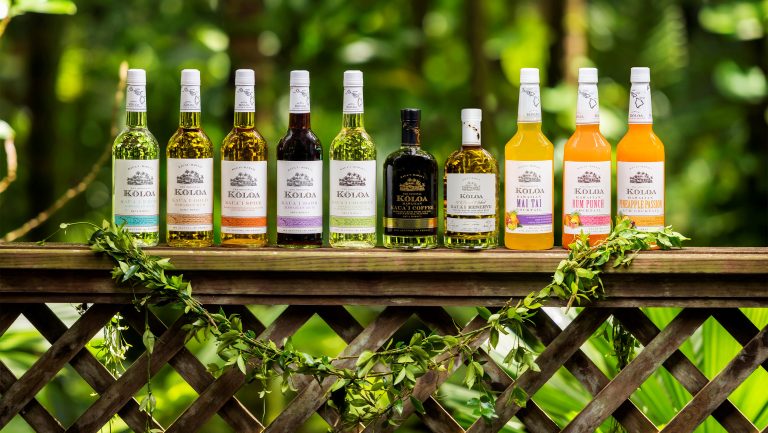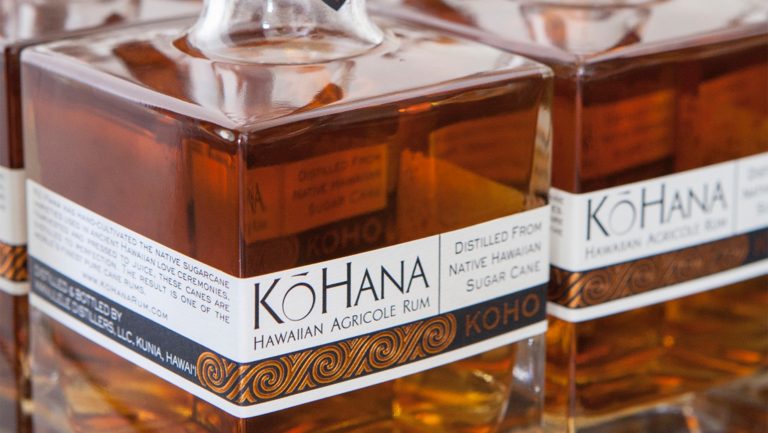While rum can be distilled in many parts of the world, its foundation and origin lie in the Caribbean. But recently, a growing rum movement has emerged from another set of islands—one with deep roots in sugarcane, new distilling techniques, and a terroir that is primed for rum distilling. These islands? Hawaii.
Despite a long history of sugarcane production and minor forays into rum production in the 1960s and 70s, the Hawaiian Islands did not have a meaningful rum industry until just over a decade ago. But thanks to intrepid distillers with a desire to return to the islands’ cultural roots, Hawaii has established itself as a growing source of expressive rum. Though the Hawaiian rum industry is tiny, it’s quickly finding its niche within the category as producers focus on reviving native varieties of sugarcane. The result is an energetic set of rums that taste distinctly of Hawaii.
A Missed Opportunity
Brought to the Hawaiian Islands by the Polynesians approximately 1,500 years ago, sugarcane became a sacred, life-sustaining crop. By the 1800s, sugarcane plantations were abundant in Hawaii and provided a boon to the island’s burgeoning economy. While those in the Caribbean focused on rum, Hawaii’s locals concentrated on exporting sugar.

Don’t miss the latest drinks industry news and insights. Sign up for our award-winning Daily Dispatch newsletter—delivered to your inbox every week.
“[Sugarcane production] is deeply rooted in the history of Hawaiian culture and was one of the few selected plants to come along with Hawaii’s first inhabitants,” says Suzanne Navarro, co-owner of Esters Fair Prospect, a cocktail bar in Maui, Hawaii. “It was a life-sustaining crop that eventually became a huge industry in Hawaii.”
The sugar industry was Hawaii’s calling card for centuries, made even more lucrative by the reciprocity agreement the U.S. signed in 1875 with the Kingdom of Hawaii, allowing the trade of sugar and cotton to flourish. Built on the backs of immigrant labor and land leasing, the rules changed in 1959 when Hawaii became a state. As labor became more expensive, plantation owners abandoned the sugar trade in Hawaii and set up shop in underdeveloped countries.
Unfortunately, after its heyday, sugarcane was mostly forgotten, and the plethora of varieties native to the islands slowly began to disappear. Sugar plantations had only cultivated the varieties that would bring in the most cash, leaving the other types to wilt and wither. But, a small group of individuals held on to a desire to restore the native plant and embrace a part of the island chain’s lost culture.
“Rums are being made here now with a unique sense of place [while] honoring the history of native cane. They taste like Hawaii and are very different from other rums of the same style.” —Suzanne Navarro, Esters Fair Prospect
In the late aughts, Hawaii’s version of the island staple finally began to take root. Four innovative distillers came along, including Kuleana Rum Works, Kōloa Rum Co., Hali’imaile Distilling, and Kō Hana Distillers. Kōloa, says Kyle Reutner, the general manager at Oahu, Hawaii-based Kō Hana Distillers, was the trendsetter, making rum on Kaua’i, the original batches made from the last sugar from a famous plantation on that island.
“We thought it would be truly amazing to see sugarcane used in a less commodified space,” says Reutner. “In the 1900s, cane was considered a plant to extract sugar from and that was all. We thought these plants could really be showcased in a light that had never been done.”
Hawaii’s ideal environment for growing sugarcane may be the basis of the islands’ eventual distilling prowess, but there are several other things that make it a distiller’s playground, adds Reutner. “Chiefly, the climate is why [Hawaii] is an amazing place to grow cane, and therefore, make rum. We are able to harvest and plant almost 12 months a year. Our volcanic soil, diverse and interesting agrotourism, and agricultural history also plays into making it a gem for rum making.”

A New Kind of Rum
Because other rum cultures have been around for centuries, many of the pioneering islands and regions have established classic flavor profiles based on traditions, regulations, and terroir. But Hawaii’s distillers are doing things their own way, taking a more experimental approach to cultivating the islands’ rum culture.
“The rums of the Caribbean tend to have strict rules about how they believe it ‘should’ be done and they follow that,” says Reutner. “We are all still creating our lanes, and that allows us to embrace techniques that might not have been available 100 years ago. [It also allows us to make] choices as to what styles we want to borrow from.”
Hawaii is not just making the classic white, dark, and gold rums either. With spiced and flavored rums becoming increasingly attractive to cocktail creators and drinkers—Distilled Spirits Council of the United States (DISCUS) notes that flavored and spiced rums now account for more than 56 percent of all rums sold—Hawaii’s producers are embracing these styles and are therefore poised for growth. Kōloa Rum Co. has been focused on its expanded rum offerings, including Kōloa Kaua’i Spice Rum and other flavored rums such as coconut, coffee and cacao, in addition to its classically styled rums. “It’s the richness and diversity of our rums that is attracting more consumers,” says Bob Gunter, the president and CEO of Kōloa Rum Co.
Whether traditional or newer in style, Hawaiian rums bring more than just another brand of spirit to add to the bar. Navarro says that these rums are a reflection of Hawaii as a whole, giving sippers a taste of the islands that hasn’t been available in the past. “Rums are being made here now with a unique sense of place [while] honoring the history of native cane,” she says. “These rums have funk, flavor, grassy freshness, and tropical notes. They taste like Hawaii and are very different from other rums of the same style.”
The trick to using Hawaiian rum is to really let the ingredients shine and to allow the drinker to realize what is special about this spirit, says Navarro. “Let’s be honest, if you want to taste a Hawaiian rum in all of its terroir-driven glory, a classic daiquiri is the way to go,” she says. “Simple—fresh lime, sugar (bonus points for using cane syrup), and delicious Hawaiian rum.”
But that’s not the only way to appreciate what rum distillers are doing in Hawaii. Lynnette Marrero, the bar director at Llama San and Llama Inn in New York City, the cofounder of Speed Rack, and a Masterclass.com educator, says that when creating cocktails using rum from Hawaii, she uses complementary flavor profiles that will transport the drinker to the state—something that has gotten much easier since the rums have unique attributes from Hawaii’s soil and water.
“I tend to find the Hawaiian rums have a slightly fruitier aroma, whereas Caribbean rums tend to lean into spice notes like vanilla, caramel, and baking spices.” she says. “Hawaii is so beautiful and is such a special place. So I would honor that with the flavors I pair with it.”

A Promising Future
According to the DISCUS, 24.7 million nine-liter cases of rum were sold in the United States, generating nearly $2.5 billion in revenue for distillers in 2021. But, as the rum segment is diversifying, it is also being reflected in sipping culture.
It may have taken a bit to get started, but Hawaiian rum is growing—not only on the islands, but on the U.S. mainland as well. Still, availability outside of Hawaii is limited. According to the U.S. Census Bureau, in 2014, exports of Hawaiian rum to the world were valued at $43,990; by 2021, they reached $74,009. While small, the growth is substantial for an industry that has little more than a decade on the books.
“We are now able to export products truly of Hawaii,” says Reutner. “And by truly of Hawaii, I mean grown here, fermented, distilled, and bottled, helping to really allow people to get a taste of Hawaii wherever the bottle is on the globe.”
All of the major distillers have worked to create a sense of place in their spirits and each has dedicated themselves to rejuvenating the once prized-crop of Hawaii. But, there are still certain challenges that are keeping the process from growing as quickly as it could.
“[Hawaiian rum makers] just have a much more involved and hands-on process than a company who sources the molasses or just purchases rum already made,” explains Reutner. “I view that as the largest hurdle. Finding a way that the agricultural side of the operations can work for the distilleries is massively important. That said, the styles brought out from each house are vastly different and I think that will play really well into the future of Hawaiian rum.”
Emily Cappiello is an experienced travel, food and beverage writer, often writing about the intersection of delicious bites, sips, and travel adventures.